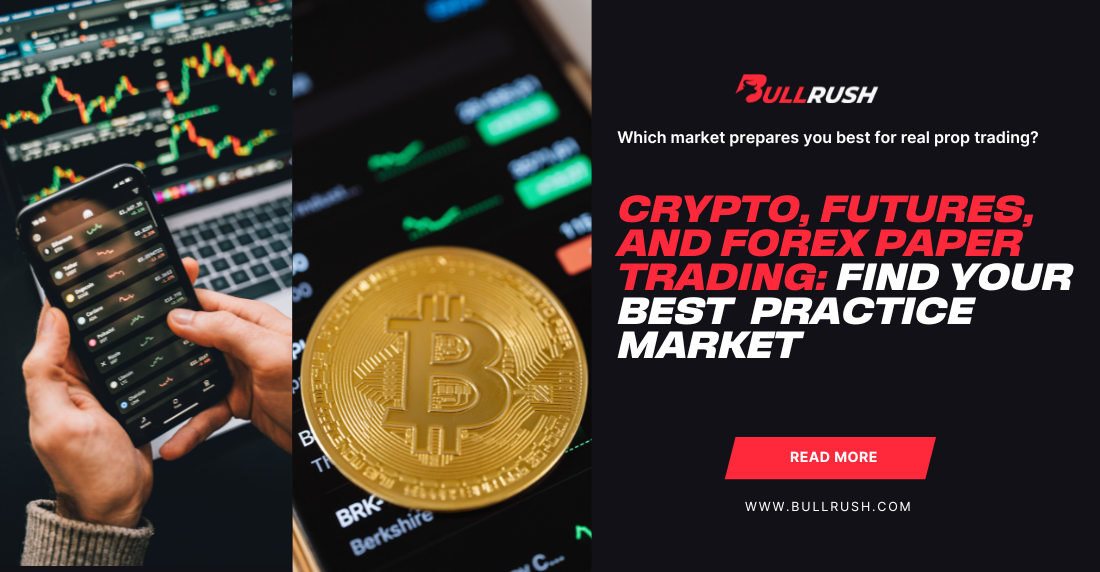
Crypto, Futures, and Forex Paper Trading: Find Your Best Market
Paper trading has become the training ground for modern traders, and today you’re not limited to just one market. You can practice volatility in crypto markets before breakfast, futures momentum during the session, and forex precision at night, all without risking a cent.
But here’s the real question: which market prepares you best for real prop trading? And how do crypto, futures, and forex paper trading stack up when it comes to building discipline, refining strategy, and stress-testing your edge?
Let’s break down each market, how their paper trading environments behave, and how to use them to sharpen your execution before stepping into live capital.
Crypto Paper Trading 101
Crypto paper trading feels like learning to surf by jumping straight into a wave pool. Markets run around the clock, liquidity changes in a heartbeat, and volatility can flip from calm to chaotic in seconds.
Crypto simulators help you get comfortable with nonlinear moves: breakouts that overshoot, wicks that weaponize liquidity, and structural shifts driven by news or sentiment.
Why Crypto Paper Trading Helps You Level Up
Crypto teaches adaptability. It forces you to adjust quickly, develop a sense for momentum, and build emotional resilience in fast-moving environments.
Tip: Practice sizing positions smaller than you think you need. Crypto exaggerates mistakes.
- Prepares you for volatile conditions
- Great for learning reaction speed
- Strong training for breakout and momentum strategies
Futures Paper Trading 101
If crypto feels like chaos, futures are the opposite: structured, rhythmic, and incredibly sensitive to timing. Futures paper trading trains you to read order flow, understand microstructure, and react to news events that slam into markets with force.
The best part? Futures offer clear session times, meaning you can train in concentrated bursts that mimic real prop trading conditions.
Why Futures Paper Trading Builds Discipline
Trading futures in a simulator forces you to get serious about entries, stop placement, and system execution. The market doesn’t reward randomness; it rewards accuracy.
Tip: Use paper trading to refine your news-event playbook. Futures move sharply around data releases.
- Tight spreads and deep liquidity
- Great for scalpers and intraday traders
- Helps refine timing and order execution
Forex Paper Trading 101
Forex paper trading is where many traders develop long-term skill because FX behaves like a machine: liquid, stable, and deeply influenced by macro trends. Instead of explosive spikes, you get flowing movement that rewards patience and structured analysis.
The 24/5 nature of forex makes it a perfect middle ground between crypto’s chaos and futures’ strict sessions.
Why Forex Paper Trading Sharpens Structure
Practicing in the forex market strengthens technical discipline, risk management, and consistency. FX is less about surprises and more about steady execution.
Tip: Use your forex paper trading logs to study how different sessions (Asian, London, New York) impact volatility.
- Smooth, trending price action
- Teaches patience and risk control
- Ideal for swing traders and systematic approaches
Which Market Should You Paper Trade First?
Each market behaves like its own ecosystem: Crypto rewards speed and adaptability. Futures reward precision and timing. Forex rewards consistency and structure.
If you’re not sure where to begin, use this rule of thumb:
- Choose crypto if you like momentum and fast-paced decision-making.
- Choose futures if timing and microstructure fascinate you.
- Choose forex if you want steady, repeatable setups to refine discipline.
Tip: Rotate through all three for one month each. You’ll quickly learn which environment brings out your strengths.
How Paper Trading Translates to Real Markets
The biggest mistake traders make is treating paper trading like a game. The moment you start clicking buttons carelessly, you’re training the wrong habits.
In any market: crypto, futures, or forex paper trading, the point is to simulate real-money behavior:
- Respect your stop losses
- Follow your trading plan
- Review every trade
- Track emotional reactions
- Build repeatable systems
Paper trading isn’t just practice; it’s performance rehearsal.
- Your habits transfer directly to live trading
- Emotional awareness is as important as technical skill
- Paper trading is your blueprint for funded performance
The Best Way to Use Paper Trading for Prop Success
Your goal isn’t to “win” a simulation: it’s to collect data, refine structure, and develop confidence in your execution. Track your metrics, measure your edge, and let paper trading become the foundation for your prop journey.
Tip: Only move to real challenges when you’ve proven your system over at least 30–60 simulated sessions.
- Paper trading is a testing lab
- Focus on consistency over flashy results
- Systems built slow become systems that survive long
BullRush: Your Next Step After Paper Trading
Once your paper trading foundation is solid, whether from crypto, futures, or forex, the next move is stepping into a transparent ecosystem where skill really matters.
BullRush gives traders market execution, clean rules, on-demand payouts, and a structure built for growth, not gimmicks.
When you’re ready to take your training into live conditions, start a BullRush Challenge and put your refined strategy to the test.
FAQs: Crypto vs Futures vs Forex Paper Trading
Q: What is forex paper trading?
A risk-free arena to practice trading currency pairs and lock in your strategy before going live.
Q: Which market is easiest for beginners?
Forex. Clean structure, steady moves, and enough liquidity to learn without chaos.
Q: Does crypto paper trading feel like real trading?
Technically yes, emotionally no. It’s great for testing setups but can’t mimic crypto’s real-money adrenaline.
Q: Why try futures paper trading?
It forces precision. Fast moves and fixed tick values make you respect risk instantly.
Q: Should I test all three markets first?
Definitely. Each market stresses different skills, and trying all three shows you where you truly perform best



